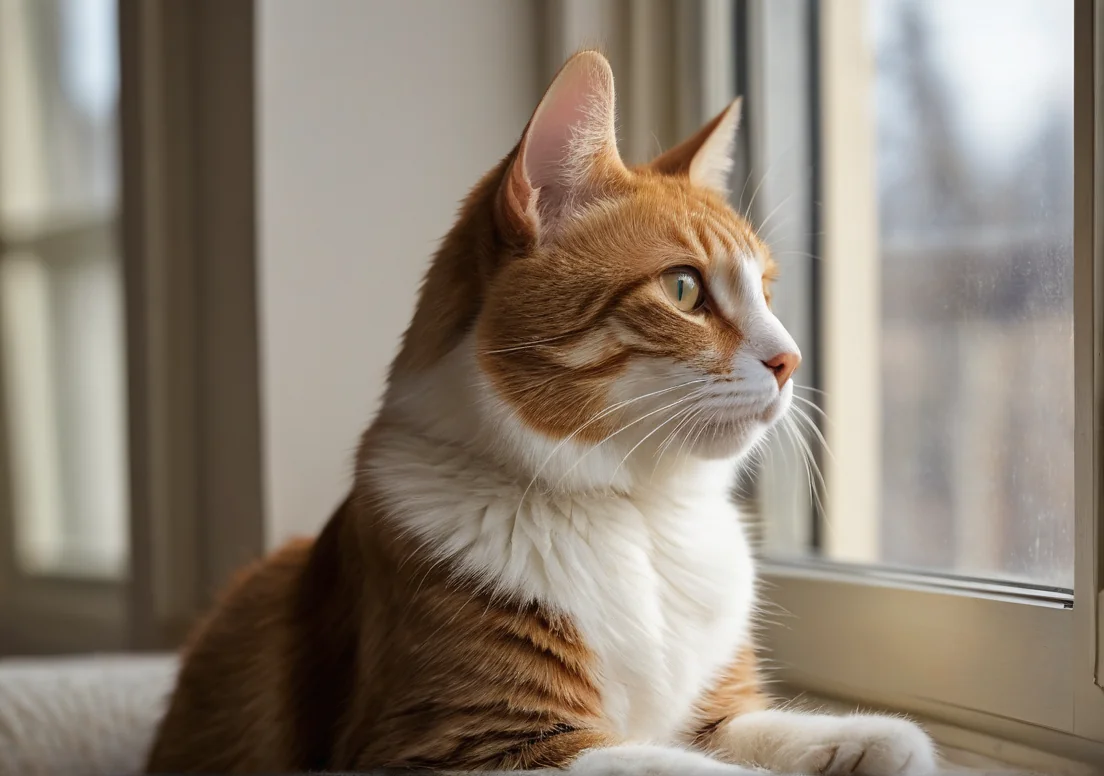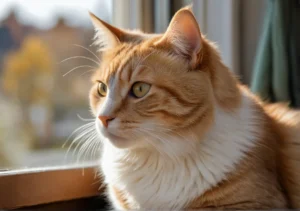Have you noticed how cats often find themselves perched by the window, gazing out into the world? It’s a familiar scene in homes with feline companions, one that makes us curious about their fascination.
Cats are drawn to the window because it stimulates their natural instincts. They love watching birds, cars, and the hustle and bustle of life outside, satisfying their curiosity and providing mental stimulation. Of course, there’s much more to this behavior than meets the eye, and the reasons might just surprise you!

Natural instincts at play
A cat gazing out the window isn’t just a cute quirk; it taps into deep-rooted evolutionary behaviors. Domestic cats are descendants of solitary hunters, primarily small wildcats. Their ancestors thrived on their ability to stalk and pounce on prey, making those keen observational skills vital to survival.
This instinctual tendency to survey their territory translates to modern indoor living. When cats perch by the window, they’re engaging in natural surveillance—scanning for potential prey or observing the activity in their environment. The sights and sounds from outside can mimic those of the wild, activating instincts that scream “predator” even in a cushy home setting. Cats can be curious watchers, turning into little nature enthusiasts as they explore the world outside while remaining safe inside.
Interestingly, this territorial behavior often extends beyond just looking for food. Cats are also marking their territory when they watch. Their gazes assert their dominance over the space, reminding unseen intruders that they’re in charge—even if it’s just the neighbor’s pesky squirrel.
The allure of movement
Cats are wired to react to motion. Whether it’s a fluttering bird or the rustle of leaves, they’re naturally drawn to anything that moves, triggering their predatory instincts. This responsiveness to movement is a cornerstone of their hunting strategy. Outside the window, life unfolds in captivating ways, providing endless entertainment.
When cats watch dynamic scenes, they’re not just observers; they’re mentally engaged in a thrilling hunt. The sight of a squirrel darting across the yard or the delicate flight of a butterfly can send their tail twitching and eyes wide with excitement. It’s nature’s own version of cat TV and can be a great mental stimulation for them.
Here’s a quick list of what cats commonly find fascinating as they watch the world outside:
- Birds: The chirping and flapping wings capture their attention, igniting their inner hunter.
- Insects: Small, quick movements from bugs can provoke a playful pounce.
- Cars or Bicycles: The speed and variety keep their instincts on alert.
- Other Animals: Cats are social observers, often intrigued by the behaviors of their furry neighbors.
- Leaf Movement: Even the rustling of leaves can fascinate them, showcasing their heightened sensitivity to motion.
These natural instincts combined with the allure of movement explain why your cat stands guard by the window so often. It’s a blend of instinctual behavior and a natural curiosity that keeps them glued to that spot.
Elevation is key
Cats are natural predators, and looking out the window can mimic the feeling of being in a high vantage point. Elevated spaces provide a sense of safety, allowing them to assess their surroundings without the threat of being vulnerable. This instinctual behavior often makes them feel secure and comforted. You might notice your kitty perched on the windowsill, tail twitching in anticipation. This is not just about seeing; it’s also a way for them to observe and gauge potential “prey”—whether that’s birds, squirrels, or even passing humans. It taps into their instinctive drive to hunt, which is crucial for their mental well-being.
Also, when they’re perched high up, they can choose when to engage or retreat—allowing them a degree of control over their environment that they find comforting. If you want to enhance this setup, consider adding a cat tree or designated climbing space near the window. It provides a safe, elevated place where they can feel in charge.
Boredom buster
For indoor cats, routine can become stale quickly, and watching the outside world offers a great dose of stimulation. Instead of simply pacing around or trying to find trouble indoors, looking out the window presents an ever-changing show right at their paws.
This window view brings life to their day; they might be entertained by:
- Birds chirping and flitting about
- Squirrels scurrying up trees
- Humans walking their dogs
All these external activities can prevent boredom and keep them mentally sharp. Moreover, the sounds and movements outside can hone their instincts and keep them engaged.
One unique insight is setting up a bird feeder outside your window. This draws even more wildlife in and provides hours of entertainment for your cat. The sights and sounds will make their daily routine feel a lot more vibrant and exciting, catering perfectly to their natural instincts while offering you endless amusement as well.
Environmental enrichment
Cats are natural hunters and curious creatures. Windows offer a prime spot for them to enjoy sensory stimulation by showcasing a world filled with movement and interesting sounds. Watching birds flutter, leaves rustle, or even cars zoom by engages a cat’s instincts and keeps them entertained. The sights outside can spark their predatory behavior, which helps relieve boredom and reduces the chances of developing unwanted habits, like scratching furniture or knocking things over. Not only do they get to see, but they can also hear and smell what’s happening in the outside world, from the sweet scent of fresh grass to the distant barking of a dog.
To enhance this experience, consider setting up a cozy window perch. A soft blanket or a cat bed can transform that window into a comfy observation post. Some cats might even enjoy watching their humans work or socialize outside, further strengthening their bond with their family.
Safe observation point
For cats, windows serve as a sanctuary where they can observe their surroundings without fear. Unlike outdoor life, where threats lurk around every corner, a window offers a secure vantage point. Here, cats can watch other animals, vehicles, and humans while feeling completely safe within the home. This helps satisfy their natural hunting instinct, allowing them to take in the action without the risks associated with the great outdoors.
Additionally, being able to watch the world unfold outside might contribute to a cat’s mental well-being. They can gauge potential threats without feeling exposed, which can be comforting. It’s especially beneficial for indoor cats who may feel restricted; this little glimpse into the outside world can alleviate some of that pent-up energy and tension.
So, if your feline friend permanently claims that sunny spot by the window, it’s not just for the warmth. It’s a cherished space that feeds their instincts and keeps them feeling secure while staying connected to the outside world.
Cats aren’t just looking for a comfy spot by the window; they’re engaging in a form of social observation. Watching the world outside satisfies their natural curiosity. It’s like having a front-row seat to a reality show—squirrels darting around, birds flitting by, or even people strolling past. This behavior fulfills their instinctual need to gauge their surroundings and stay informed about potential prey or threats.
Moreover, if you’ve got multiple pets or even kids, watching the outdoor activity can provide a way for your cat to interact with their environment without feeling the pressure of social engagement. You’ll often notice them getting more animated as they observe movements, craning their necks or twitching their tails as if plotting their next adventure. It’s a form of social stimulation that keeps their minds sharp and intrigued.
Fun feline facts
Cats have some fascinating quirks when it comes to their window-watching habits. Here are a few intriguing insights:
- Height Matters: Cats prefer high perches. Elevating a cat tree by a window can enhance their viewing pleasure and give them a sense of safety.
- Time Spent: A study by the Journal of Feline Medicine and Surgery reported that cats can spend over 80% of their waking hours just observing the outside world.
- Color Vision: Unlike humans, cats see colors differently. They may not appreciate a bright garden as much as we do, but they’re particularly tuned in to motion, making even a rustling leaf captivating.
- Predatory Instincts: Watching birds or squirrels fulfills their hunting instinct, providing mental stimulation that plays into their natural behaviors.
- Routine Observers: Cats often develop watching routines, frequently checking their favorite spots to see what’s changed since their last look.
These behaviors aren’t just cute; they’re deeply rooted in their instincts, serving purposes that go beyond mere fascination.
Alex, a passionate animal lover, has experience in training and understanding animal behavior. As a proud pet parent to two dogs and three cats, he founded AnimalReport.net to share insights from animal experts and expand his knowledge of the animal kingdom.




